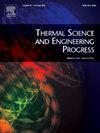Surface roughness and dimensional evaluation of laser powder bed fusion additively manufactured shell and tube heat exchangers
IF 5.4
3区 工程技术
Q2 ENERGY & FUELS
引用次数: 0
Abstract
The growing interest in additively manufactured (AM) heat exchangers drove the need to understand how this construction technique impacts heat exchanger performance. Two primary factors driven by AM that influence heat exchanger performance are surface roughness and geometry. To better understand these parameters, a range of shell and tube heat exchangers constructed using laser powder bed fusion were evaluated. Of those evaluated, the surface roughness throughout a fourteen-tube, zero-baffle heat exchanger was measured using computed tomography. Between the inner and outer tubes, the inner tube surfaces had a greater surface roughness than the outer by 8.07 μm, while the surfaces at the top of the build volume had higher surface roughness values than the bottom. Dimensionally, the inner tube diameters of this heat exchanger were 0.15 % different from the design value, while the outer diameters were within a 0.84 % difference. Manual measurements across seven other heat exchangers yielded a maximum 1.15 % difference between the design and measured diameters. Across the build volume for all heat exchangers studied, the tube diameters at the top were larger than at the bottom by a maximum of 1.24 % difference. Inconsistent melting throughout the individual parts and the build volume, as well as particle splatter and thermal gradient variation were attributed to the surface roughness and dimensional changes seen. These results strengthen the knowledge of dimensional and surface roughness considerations when designing AM heat exchangers.
激光粉末床熔融增材制造管壳式换热器的表面粗糙度及尺寸评定
随着人们对增材制造(AM)热交换器的兴趣日益浓厚,人们需要了解这种构造技术如何影响热交换器的性能。由增材制造驱动的影响换热器性能的两个主要因素是表面粗糙度和几何形状。为了更好地理解这些参数,我们对一系列采用激光粉末床熔合技术构建的管壳式换热器进行了评价。在这些评估中,使用计算机断层扫描测量了整个14管零挡板热交换器的表面粗糙度。内外管之间,内管表面粗糙度比外管表面粗糙度大8.07 μm,而构建体顶部表面粗糙度值高于底部。在尺寸上,该换热器的内径与设计值相差0.15%,而外径相差在0.84%以内。手动测量其他七个热交换器的设计直径和测量直径之间的最大差异为1.15%。在研究的所有热交换器的整个构建体积中,顶部的管径比底部的管径大,最大差值为1.24%。由于表面粗糙度和尺寸变化,单个部件和构建体积的不一致熔化,以及颗粒飞溅和热梯度变化。这些结果加强了在设计增材制造换热器时对尺寸和表面粗糙度考虑的认识。
本文章由计算机程序翻译,如有差异,请以英文原文为准。
求助全文
约1分钟内获得全文
求助全文
来源期刊

Thermal Science and Engineering Progress
Chemical Engineering-Fluid Flow and Transfer Processes
CiteScore
7.20
自引率
10.40%
发文量
327
审稿时长
41 days
期刊介绍:
Thermal Science and Engineering Progress (TSEP) publishes original, high-quality research articles that span activities ranging from fundamental scientific research and discussion of the more controversial thermodynamic theories, to developments in thermal engineering that are in many instances examples of the way scientists and engineers are addressing the challenges facing a growing population – smart cities and global warming – maximising thermodynamic efficiencies and minimising all heat losses. It is intended that these will be of current relevance and interest to industry, academia and other practitioners. It is evident that many specialised journals in thermal and, to some extent, in fluid disciplines tend to focus on topics that can be classified as fundamental in nature, or are ‘applied’ and near-market. Thermal Science and Engineering Progress will bridge the gap between these two areas, allowing authors to make an easy choice, should they or a journal editor feel that their papers are ‘out of scope’ when considering other journals. The range of topics covered by Thermal Science and Engineering Progress addresses the rapid rate of development being made in thermal transfer processes as they affect traditional fields, and important growth in the topical research areas of aerospace, thermal biological and medical systems, electronics and nano-technologies, renewable energy systems, food production (including agriculture), and the need to minimise man-made thermal impacts on climate change. Review articles on appropriate topics for TSEP are encouraged, although until TSEP is fully established, these will be limited in number. Before submitting such articles, please contact one of the Editors, or a member of the Editorial Advisory Board with an outline of your proposal and your expertise in the area of your review.
 求助内容:
求助内容: 应助结果提醒方式:
应助结果提醒方式:


